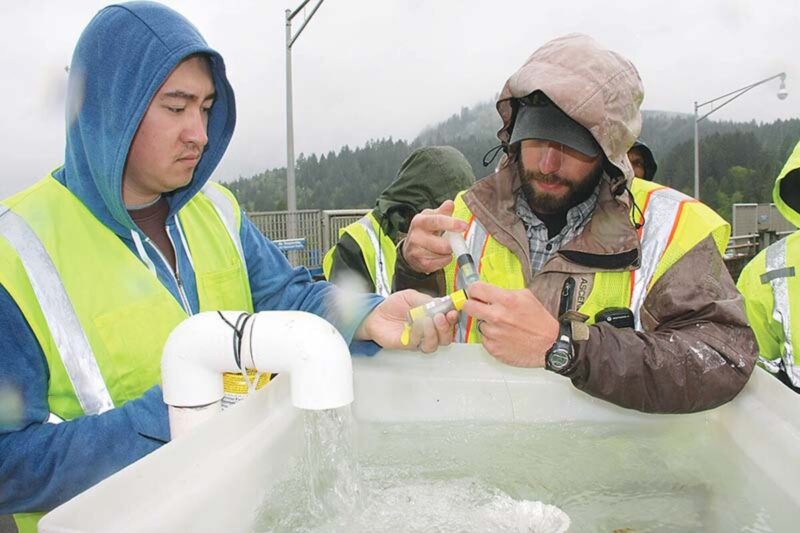Sean C. Morgan
U.S. Army Corps of Engineers fish biologist Fenton Khan is confident the new weir at Foster Dam will improve fish passage downstream for winter steelhead and spring Chinook.
Providing more flow and a fish-friendly shape, he believes it will cause less injury and improve downstream passage, but at this point, it’s just a hypothesis.
Now he must find out if the weir is working as intended.
Corps officials last week spent Monday through Sunday in a post-construction evaluation testing that hypothesis at low pool and running hatchery fish through over the weir to determine if it decreased injuries and improved fish survival and sensor fish to measure the forces involved in falling over the dam’s spillway.
The weir is meant to help juvenile Chinook, but it also must accommodate adult steelhead, which migrate back out to sea after spawning and may return to their spawning grounds multiple times in their lives.
While Chinook runs are doing all right, Khan said, steelhead had declined from an estimated 600 to 700 each season to 20 to 50.
“We want to make passage for the steelhead safer,” Khan said. “We want them to come back again and have more offspring.”
During the seven days of testing, researchers tagged live fish provided by the South Santiam Fish Hatchery and attached a balloon tagging system that allowed researchers to find and collect the fish from the river below the dam.
The test allows researchers to identify direct injuries to fish traveling over the weir and survival rates, Khan said. The sensor fish, plastic devices carrying various instruments, measure acceleration, speed and the strength of impacts. That information tells researchers where the bruises and injuries on the fish are coming from.
“We will use this data and compare it to the old fish weir data,” Khan said. His goal is minimal injuries, though he observed that a system to get over the dam will always cause scrapes and bruises.
“It’d be nice to be injury-free, but I think we’ll get to minimal injuries,” Khan said.
Normandeau Associates, Inc., of Pennsylvania conducted the research with live fish, Khan said. The company invented the balloon tags used in the testing.
Pacific Northwest National Laboratory of Richland, Wash., conducted the sensor fish and telemetry testing, Khan said.
The weir, which constrains the release of water to maintain flow requirements, is a metallic wall measuring 47 feet in length, 10 feet in height and 3 feet 7 inches in thickness. It sits on top of three stop logs, metal beams that dam the water from Foster Reservoir. A large opening in the weir allows water through. The weir and stop logs fit into slots in the spillway beneath Foster Dam Road.
The Corps replaced the weir in February at a cost of about $400,000. The new weir was shaped to more closely mimic a natural waterfall, Khan said, providing more volume and a deeper cushion of water as the fall hits the spillway. Using the old weir, the fish landed on the concrete, injuring them.
The weir was also designed to attract more fish, helping them avoid the turbine intake. Both species are surface-oriented fish and attracted by motion on the surface of the lake.
The old weir provided flows of 200 to 250 cubic feet per second. The new weir has a range of 300 to 800 cfs and will typically run at 500 cfs.
To complete testing, the Corps will begin filling Foster this week, and researchers will return for seven days in mid-June for the same testing at full pool.
During the testing, the Corps closed access during the day to Foster Dam Road, and it will close the road during the day again in mid-June.
“We do appreciate the local residents’ understanding of the road closure,” Khan said.





